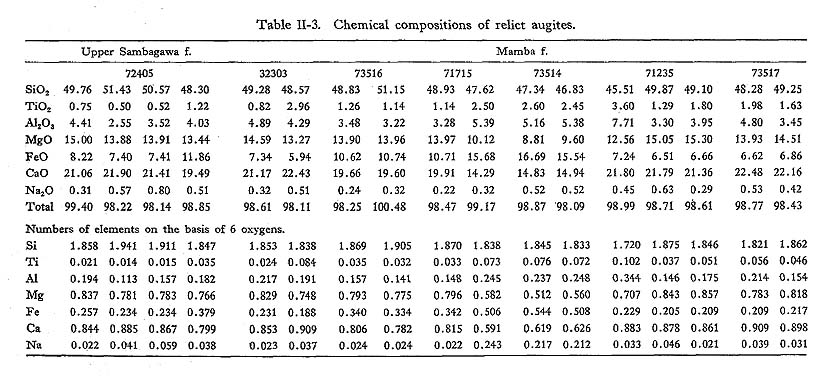i) Introduction
The rocks of the Chichibu and Sambagawa groups are widely exposed in the orthern Kanto Mountains. Lithologically, FUJIMOTO (1935), CRG (1961), and OKUBO and HORIGUCHI (1969) have suggested that the boundary between the Chichibu and Sambagawa groups is a fault zone, Mikabu Tectonic Line, while UCHIDA (1967) discussed the possibility of the conformable succession between them. Further, CRG, UCHIDA, and OKUBO and HORIGUCHI have pointed out that the gentle folded structure prevails through the Chichibu and Sambagawa groups.
According to them, the upper part of the Chichibu group is of the Upper to Middle Permian age (Neoschwagerina-Yabeina zone) and the lower part of the Lower Permian age (Pseudofusulina zone).
However, K.OIKE et al (1971) have found Triassic conodonts at the Jomine Mountain and Nagasawa-machi of Chichibu area, and concluded that the upper part of the Chichibu group is of the Middle to Upper Triassic ages. In this chapter, the stratigraphical relation of formations will be described and sedimantary ages of them also be discussed on the basis of the lithology of sedimentary rocks and the occurrences of fossils.
ii) Stratigraphy
The Sambagawa group can be divided into two formations; the Lower Samba gawa and Upper Sambagawa formations. The Upper Sambagawa formation is composed mainly of basic pyroclastic rocks intercalated with thin layers of mud stone and sandstone and their alternation, while the Lower Sambagawa formation consists of sandstone, mudstone and chert, and their alternation with thin layers of basic tuff. The Chichibu group is divided lithologically into three formations, the Kashiwagi, Mamba and Kamiyoshida formations in the ascending order of strati graphy. The definitions of these formations follow those of OKUBO and HORIGUCHI (1969).
a) The Sambagawa group
The Lower Sambagawa formation
This formation consists of sandstone, mudstone and chert, and their alternation with thin layers of basic tuff. The lower part of this formation is composed of basic laminated tuff, and the upper part consists of thick layers of sandstone and mud stone with chert beds. Bedded chert with mudstone and basic tuff thin layers is interbedded in the thick mudstone layer which overlies the basic pyroclastic rocks. This mudstone layer measures 100 meters thick and contains sandstone beds with 50 centi-meters thickness. These sandstone beds become frequent with ascending stratigraphical succession of mudstone layer. The upper part of this formation is he alternating sandstone and mudstone with some of basic tuff layers. The columner section of this formation is shown in Fig. II-1. Typical section can be ob served along the Sennosawa. This formation measures more than 500 meters thick.
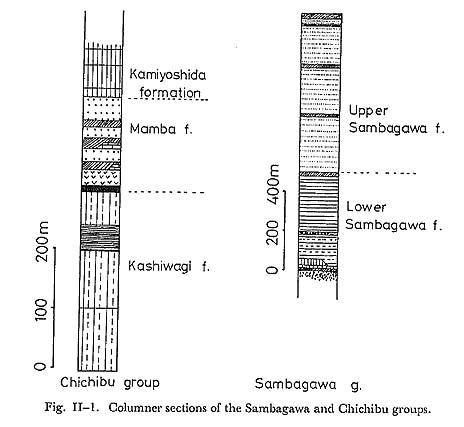
The Upper Sambagawa formation
This formation is subdivided into three members by two layers of sandstone and mudstone alternation. These two layers are described as follows, in the ascending order of stratigraphy.
- Layer 1.
- Mudstone and sandstone with small amount of chert. Its thickness is about 5 meters.
- Layer 2.
- Mudstone with small amount of basic tuff and chert, and measures 10 meter thick.
The formation consists of basic tuff, lava, lapilli tuff, tuff breccia and is accom panied by dolerite, gabbro and peridotite intrusions. The pyroclastic rocks of this formation do not contain accidental lithic fragments, thereby showing their pri mary nature of deposition. The total thickness varies from route to route and along the river Kanna-gawa it is about 800 meters.
b) The Chichibu group
FUJIMOTO, UCHIDA, and OKUBO and HORIGUCHI divided the Chichibu group into three formations; the Kashiwagi, Mamba, and Kamiyoshida formations in the ascending order. The columner section of this group is shown in Fig. II-1.
The Kashiwagi formation
This formation consists of chert and muddy chert with thin layers of lapilli tuff and pillow lava (refer to UCHIDA, 1967). Red bedded chert are interbedded into muddy chert, being associated with basic tuff. It is also accompanied by massive, partly bedded limestone, which measures 20 to 30 meters thick. No fossil of cono donts and fusulinellae is found in this formation. This formation measures about 400 meters thick.
The Mamba formation
This formation is composed of basic pyroclastic rocks, lenticular limestone mass, carbonaceous mudstone, red slate and so-called mud-breccia. The mud-con glomerate contains the angular breccias of chert and bedded chert. These breccias do not affect the disturbance of matrix surrounding them. Therefore, mud-breccia is the slumping deposit but not the fractured mudstone and chert alternation (OKUBO and HORIGXJCHI, 1969).
The pyroclastic rocks consist of tuff, lapilli tuff, tuff breccia, lava, pillow lava of basic composition and dolerite sheet (see UCHIDA, 1967). Accidental lithic frag ments of lapilli tuff and tuff breccia are limestone, chert, and basic rocks, and they are irregularly shaped, suggesting that they are pyroclastic mud-flow deposit. The primary pyroclastic deposits also occur in the lower part of this formation and they contain the essential lithic fragments. Therefore, the Mamba formation is composed almost of secondary pyroclastic mud-flow deposits and mudstone with angular lithic fragments of chert, limestone, basic rocks and red slate, with subsidiary primary pyroclastic rocks.
Lenses of limestone yield many fusulinellae (see OKUBO and HORIGUCHI, 1969), but because of secondary nature of deposition of host rocks the fossils in limestone lenses may not indicate the sedimentary age of the Mamba formation. Therefore,it seems that the age of the Mamba formation is younger than the Middle Permian age. This formation measures about 200 meters thick to the south of Mamba town and in the Kuroda-machi.
The Kamiyoshida formation
The uppermost part of the Chichibu group is the Kamiyoshida formation, being composed of bedded chert, and alternating sandstone and mudstone with lens of basic rocks and limestone. The lower part of this formation yields many Triassic conodonts to the south of the Mamba town. This formation is correlated to the Upper to Middle Triassic by KOIKE et al, (1971), and measures more than 400 meters thick.

iii) Stratigraphical relationships
Relationship between the Sambagawa and Chichibu group; FUJIMOTO, OKUBO and HORIGUCHI have stated that the Mikabu Tectonic Line runs along the boundary between the Sambagawa and Chichibu groups. It is because a fracture zone exists along this boundary and the general strike of the bedding plane of the Chichibu group is fairly oblique to that of the Sambagawa group.
On the other hand, the author found three outcrops which show the contact between the Upper Sambagawa formation and the Kashiwagi formation at southern parts of Kami-izumi-machi and in Sakahara-machi. At these outcrops, faults are absent, and the rocks of the Kashiwagi formation are folded in the same way as those of the Upper Sambagawa formation. The contacts associated with fracture zone do not crop out. From these observations, it may be concluded that the Kashiwagi formation overlies conformably the Upper Sambagawa formation.
The boundary between the Upper and Lower Sambagawa formations; the outcrops of the boundary were found to the south of Onishi and to the north of Shimokubo towns. Thin layered alternation of sandstone, mudstone and basic pyroclastic rocks are at the boundary, suggesting that the Upper Sambagawa for mation overlies the Lower formation conformably.
Boundary between the Kashiwagi and Mamba formations; this boun dary is found at many localities; Kashiwagi, Kuroda, Otabu, and other districts. At every outcrops along this boundary, mud-breccia bed with 10 meter thickness developes and thus it seems that the Kashiwagi formation is overlain by the Mamba formation conformably.
Boundary between the Mamba and Kamiyoshida formations; the outcrops of this boundary have not been found in this area. The uppermost part of the Mamba formation are widely distributed from the southern border area of this area to the Mamba town, and it seems that the Kamiyoshida formation overlies conformably the Mamba formation.
iv) Conclusions
It is summarized that the stratigraphical succession in the studied area is con formable from the Lower Sambagawa to the Kamiyoshida formations. Neverthe less, the Atokura and Sanchu groups which are of Upper and Lower to Upper Cretaceous ages, overlie the Sambagawa and Chichibu groups unconformably (OKUBO and HORIGUCHI, 1969).
Okubo and Horiguchi have pointed out that the general strike of the Kashiwagi formation is oblique to that of the Upper Sambagawa formation, and that the frac ture zone runs along the boundary between them. However, these facts are not confirmed at the outcrops of boundary, and chert in the Kashiwagi formation is folded in the same way as basic rocks in the Upper Sambagawa formation. There fore, the fracture zone and obliqueness of general strikes of the Upper Sambagawa and Kashiwagi formations can be explained by the folds of these formations. Three outcrops of the boundary between them indicate their conformable succession.
OKUBO and HORIGUCHI have correlated the Kamiyoshida and Mamba forma tions to the Middle to Upper Permian and Middle to Lower Permian, respectively, based on the fusulinellae fauna in the limestone lenses. On the other hand, Koike et al, have discussed that the upper part of the Kamiyoshida formation is of the Upper to Middle Triassic age, based on conodont fauna in the bedded chert. Judging from the facts that limestone lenses are secondary deposits in mudstone, it is con cluded that the Kamiyoshida formation is of the Upper to Middle Triassic age as discussed by KOIKE et al.
The Mamba formation is composed mainly of mud-flow deposits of pyroclastics including chert, limestone and mudstone. Then, it seems that limestone lenses in cluding many fossils are derived from the lower horizon than the Mamba forma tion. In other words, the Mamba formation comprises the Upper Permian to Lower Triassic ages, because of the Middle to Lower Permian limestone lenses in the Mamba formation. The Shionozawa formation, which is correlated to the. Lower Triassic age, is exposed in the Shionozawa-machi to the west of the Kagawara. This formation is composed of the basic tuffaceous sandstone, mudstone, and lime stone lenses containing many fossils. The Shionozawa formation is overlain by the Kamiyoshida formation, and thus it is likely that the Shionozawa formation is correlated to the uppermost part of the Mamba formation which consists mainly of pyroclastic mud-flow deposits.
No fossil was found in the limestone of the Kashiwagi and Upper Sambagawa formations. However, mud-breccia of the lowest part of the Mamba formation includes irregular lithic fragments derived from the Kashiwagi bedded chert, and thus some of their lithic fragments in the Mamba formation may be derived from the upper part of the Kashiwagi formation. Considering from the facts that limestone lenses of the Mamba formation yield many fusulinellae of the Middle to Lower Permian, the Kashiwagi formation comprises the Lower and Middle Permian ages. Accordingly, the Sambagawa group may be of the Lower Permian to Carboniferous.
v) Geologic structure
The geologic map and cross sections of this area are shown in Figs. II-2 and II-3. The general geologic structure is governed by two trends of fold. The domi nant axial trend is in the direction of N60°W, and subsidiary trend is of N20°E. The faults are common in this area and their strikes are in the direction of N20°E,
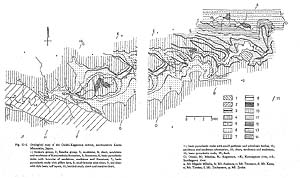
Fig. II-2. Geological map of the Onishi-Kagawara district, northwestern Kanto Mountains, Japan. |

The N60°W type major folds are accompanied by the tightly intermediate (meter
order wave length) to minor (centi-meter order) folds in the axial parts. These subsidiary folds often show the drag and flow fold styles. On the other hand, the N20°E type .major folds are accompanied by the kink folds in the well schistose rocks; and flexture-slip folds in the massive rocks. As discussed in the following sections, the direction of the schistosity plane coincides with that of N60°W type fold axis, and the schistosity is accompanied by the major folds of N60°W type. This schistosity plane is folded by the kink accompanied by the N20°E type major folds. Further, the N60°W type minor folds are also refolded by the N20°E type ones. It follows that the N60°W type fold was formed before the N20°E type ones.
Tight folds with N60°W axial direction are developed well in the area where the Upper Sambagawa formation is exposed, and in the southern marginal area of the mapped district. However, in the area in which the main parts of the Chichibu and Sambagawa group are exposed, N60°W and N20°E type gentle folds form the undulated basin and dome structure. Therefore, the mapped district can be divided into four structural units in the order southward; the Sambagawa (basin and dome), Mikabu (tightly folded zone), Mamba (basin and dome), and southern marginal (tightly folded zone) units.
The Sambagawa unit consists of two anticlinoria of N60°W and two of N20°E. These major folds are attended by many minor drag folds but not intermediate ones. The N20°E major folds are followed by kink folds bending the schistosity planes. The Mikabu unit consists of two major anticlinoria of N60°W type and one synclinorium of N20°E type. N60°W type intermediate tight folds and minor flow-type folds attend the major folds. These tight folds have the conjugated, recumbent and concentric varieties. The concentric and recumbent varieties of tight folds often show a part of the layered units of folds proposed by GURRIES et al. (1962) and studied in detail by YOSHIDA (1972). The N20°E type major fold is also accompanied by the refolding of N60°W type. The rocks of the Mikabu unit are strongly schistose. The schistosity plane is subparallel to the bedding planes in both wing parts of the folds, but in the axial parts, it is occasionally oblique to them. The Mamba unit is composed of three anticlinoria of N60°W type and three of N20°E type. These two types of major folds are also undulated, and thus they form the clear basin and dome structure. The distinct domes are situated at the Mamba and Kuroda as indicated on the geological map. The intermediate folds of N60°W type are common in the northern area of this structural unit, and show the lens type and rarely flexture type. Thus, they are accompanied by many of minor faults in their axial parts.
The rocks of this unit are weakly schistose and recrystalized, but they are frac tured and have many veins and veins filled by quartz, pumpellyite, chlorite, calcite and other metamorphic minerals as-will be described in the chapter of petrology.
The southern marginal unit consists of some anticlinoria of N60°W and N20°E types. The N60°W type folds are attended by intermediate lens folds. The veins and fractures of rocks are common in this unit.
The Sanchu and Atokura groups are also folded in the same way as the major folds of N60°W and N20°E types.
The intermediate and minor folds are common in the mudstone and pyroclastic rocks in this area. The intermediate folds can be classified into two types; the lens type fold (KIMURA, 1968), and flow fold (TURNER and WEISS, 1963). The lens type fold proposed by KIMURA is such folding that the strata is displaced by the conju gated minor faults near the axial parts and forms many lenses of rocks, while the flow fold is the folding of irregular s-surface without discrete slip texture under the naked eye.
The lens fold is common in the basic rocks of the Chichibu group, while in the Sambagawa group the flow fold is dominant.
Schistosity: The schistosity is well exposed in the basic pyroclastic rocks, al ternation of sandstone and mudstone of the Sambagawa group, while in the Chichi bu group, it is restricted in the muddy chert, and tuffaceous mudstone. Schistosity is often kinked or fractured by the N20°E type intermediate and minor folds, as mentioned above. The poles of the schistosity planes of the Sambagawa and Chichibu groups are plotted on the upper hemisphere of sterographic nets as shown in Fig. II-4. The figures indicate that the strikes of the schistosity planes cover the whole range of direction in the Sambagawa and Chichibu groups. The wide range
of the schistosity plane directions can be explained by folding of schistosity with N20°E axial direction. The N20°E type folds rotate the schistosity plane in the same way as the folding of rocks. Then, it follows that poles of the schistosity planes are also displaced along a small circle on the stereographic net. Therefore, the schistosity planes of the Sambagawa and Chichibu groups may have been rotated with pole at the top on the net by the N20°E type folds.
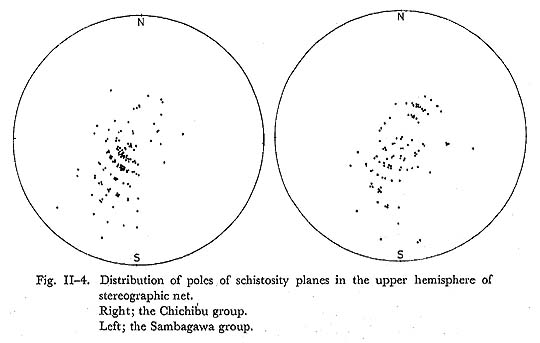
On the other hand, the wide scattered dips of the schistosity are of the same sense as the bedding planes with the N60°W type folds. This fact is also indicated by the subparallel arrangement of the schistosity and bedding planes as mentioned in the previous sections.
Axial trends of minor folds: The wave length of minor folds is of the centi meter order. Their axial trends are plotted on the upper hemisphere of the stereo graphic net as shown in Fig. II-5. This figure indicates that the axial trends of the Sambagawa group are nearly parallel to the N60°W direction, while those of the Chichibu group are scattered.

The axial trends of the Sambagawa group, being parallel to the N60°W direction, are also scattered around a plane with N20°E of pole. As mentioned in a previous section, the N20°E type major folds are attended by the N60°W type interme diate to minor folds. Thus it is concluded that the scattered pattern of minor fold axes is caused by the N20°E type folding of the Sambagawa group. Furthermore, in the Chichibu group, some of minor folds belong to the N20°E type, and thus the scattered pattern of the Chichibu group is consistent with both of the N60°W and N20°E type folds.
Duration of foldings: The N60°W type folds are developed in rocks of the Chichibu, Sambagawa, Atokura, and Sanchu groups and they are refolded by the N20°E type folding, as mentioned in a previous section. It suggests that the N60°W type is earlier than the N20°E type. Earlier N60°W type folds had taken place in period of pre- and post-Cretaceous, though age of these two deformation events can not be identified, suggesting the continuous folding during pre- and post-Cretaceous ages.
The rocks of Tertiary age exposed in the Chichibu basin are folded by the N20°E type but not by the N60°W, and thus it is likely that the N20°E type deformation occured in period of post-Tertialy age and the N60°W type one occured pre-Tertialy age. The rocks of the Chichibu basin are correlated to the Miocene, and then the N20°E type deformation took place after the Miocene. On the other hand, the N60°W type fold occurred before the Miocene. N60°W type fold is followed by the schistosity, fracture, vein, and minor folds. The fracture, and veins are filled with metamorphic minerals, and the schistosity and minor fold affect the growth of metamorphic minerals, as will be discussed in the following chapters. It follows that the N60°W type fold is contemporaneous with the regional meta morphism which occured in a period during the Jurassic and Early Cretaceous. Therefore, the N60°W type deformation occured in period from the Jurassic to Miocene (180-40mys bp).
The duration of folding mentioned above is summarized in Table II-2. As de scribed in a previous section, the N60°W type deformation is caused by the regional compressive stress having the maximum compressive direction of N20°E, judging from the N60°W type conjugated folds. This N20°E direction of maximum com pression is normal to the direction of the extention of the Sambagawa metamorphic belt in the Kanto Mountains. If the tectonic block of the Kanto Mountains had been rotated about 30° clockwise, the primary direction of the maximum compres sive direction is obtained as the N10°W being normal to the extension of the Sambagawa metamorphic belt of the Southwestern Japan Arc. This regional compressive stress may have resulted from the collision of oceanic and continental lithospheres along the trench, and then the maximum compressive axis is normal
to the trench line. The N10°W axis is normal to the Sambagawa metamorphic belt, suggesting that the belt had been parallel to the paleo-trench line. The postulate of the constant direction of the maximum compressive stress axis requires for only the condition that the metamorphic belt is parallel to the coast line and does not need the constant velocity vector of the oceanic lithosphere against the continental lithosphere. It is concluded that the metamorphic belt had been parallel to the paleo-trench line throughout the Jurassic and Miocene.

vi) Volcanic rocks
Stratigraphy: As discussed in the section of stratigraphy, the Mamba and Upper Sambagawa formations are mainly composed of basic rocks. The Mamba formation is up to 200 meters thick in the area to the south of Mamba, and the Upper Sambagawa formation is about 800 meters thick. Pyroclastic rocks of the Mamba formation consist of basaltic tuff, lapilli tuff, tuff breccia, lava and pillow lava. In the lower part of the Mamba formation, lava, pillow lava, and essential tuff breccias of basaltic composition are common, while this formation is mainly composed of mud-flow deposits of pyroclastic rocks.
On the other hand, the Upper Sambagawa formation is composed of abundant basic pyroclastic rocks showing the primary characteristics of their deposition.
Chemistry of relict augite: Representative 14 microprobe analyses of relict groundmass and microphenocryst augites in 5 specimens were carried out. A specimen was obtained from the Upper Sambagawa formation, and 4 specimens were collected from the basaltic rocks of the Mamba formation. Brief comment of rock is also made in the Appendix.
The analytical data are plotted in the Ti-Al and Si-Al diagrams (Fig. II-6, II-7), and triangular diagram having Wo (CaSiO3), Fs (FeSiO3), and En (MgSiO3) at the apices as shown in Fig. II-8. The Ti-Al diagram indicates that the chemistry of augites from the Upper Sambagawa formation shows the low Ti/Al ratio (less than 0.5), while that from the Mamba formation is high that ratio (about 0.5). Furthermore, the Ti-content of augites from the Upper Sambagawa formation is less than 1 weight per cent, while that from the Mamba formation ranges from 0.5 to 4 wt% as TiO2. Triangular diagram, however, shows that most clinopyrox-enes fall in the region of augite. According to Kushiro's diagram (KUSHIRO, 1960), the magma of the Mamba basic rocks is the type of alkali suite, and that of the Upper Sambagawa basic rocks is mainly tholeiitic.
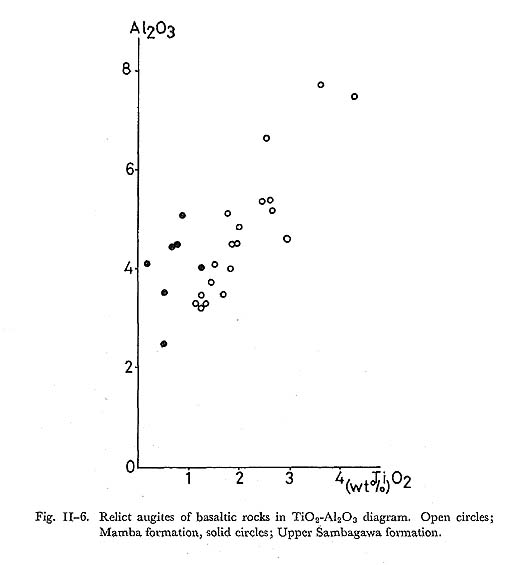
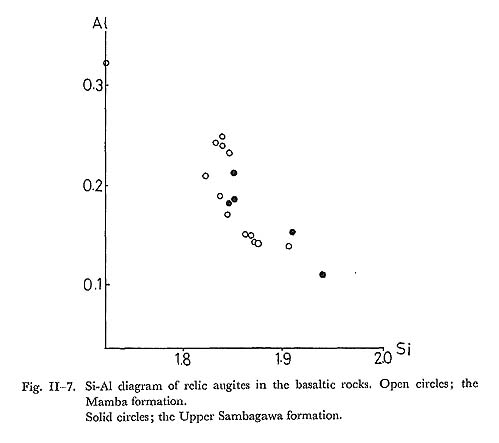

In the Upper Sambagawa formation, some of basaltic rocks contain pinkish titaniferous augites, suggesting that they are alkali basaltic suite. Further, the up permost basaltic layers of the Upper Sambagawa formation contain abundant
pinkish augites. The stratigraphical succession of volcanic rocks from the Upper Sambagawa to Mamba formations is continuous to the east of the studied area (Nagatoro area by SEKI, 1958), though in this area, it includes the thick chert beds (Kashiwagi formation) between the Mamba and Upper Sambagawa forma- tions. Therefore, alkali basaltic rocks of the Mamba formation may be related genetically to those of the Upper Sambagawa formation. However, the relation-ship between the alkali basalt and tholeiitic basalt in the Upper Sambagawa and Mamba formations was not clarified by the field observations and chemical analy- ses of augites.
Accordingly, the basaltic rocks of the Chichibu and Sambagawa groups may have been derived from the two magma types of alkalic and tholeiitic basalts. From the stratigraphical thickness of these two formations, the ratio of alkali bas- alts against tholeiitic basalts can be estimated as about 10:1.
